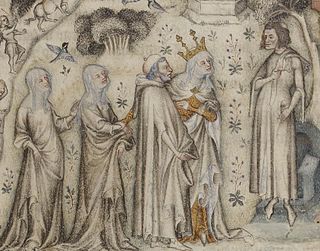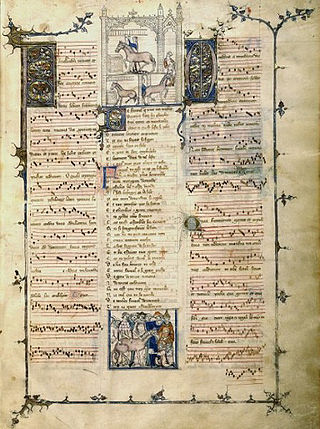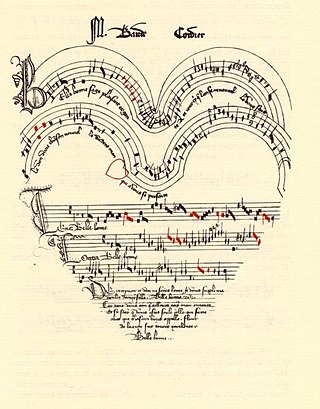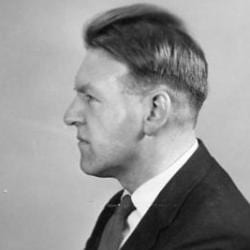Related Research Articles

Guillaume de Machaut was a French composer and poet who was the central figure of the ars nova style in late medieval music. His dominance of the genre is such that modern musicologists use his death to separate the ars nova from the subsequent ars subtilior movement. Regarded as the most significant French composer and poet of the 14th century, he is often seen as the century's leading European composer.

Jehan de Lescurel was a composer-poet of late medieval music. Jehan's extensive surviving oeuvre is an important and rare examples of the formes fixes before the time of Guillaume de Machaut; it consists of 34 works: 20 ballades, 12 rondeaus and two long narrative poems, diz entés. All but one of his compositions is monophonic, representing the end of the trouvère tradition and the beginning of the polyphonic ars nova style centered around the formes fixes.
A chanson is generally any lyric-driven French song. The term is most commonly used in English to refer either to the secular polyphonic French songs of late medieval and Renaissance music or to a specific style of French pop music which emerged in the 1950s and 1960s. The genre had origins in the monophonic songs of troubadours and trouvères, though the only polyphonic precedents were 16 works by Adam de la Halle and one by Jehan de Lescurel. Not until the ars nova composer Guillaume de Machaut did any composer write a significant number of polyphonic chansons.

Ars nova refers to a musical style which flourished in the Kingdom of France and its surroundings during the Late Middle Ages. More particularly, it refers to the period between the preparation of the Roman de Fauvel (1310s) and the death of composer Guillaume de Machaut in 1377. The term is sometimes used more generally to refer to all European polyphonic music of the fourteenth century. For instance, the term "Italian ars nova" is sometimes used to denote the music of Francesco Landini and his compatriots, although Trecento music is the more common term for the contemporary 14th-century music in Italy. The "ars" in "ars nova" can be read as "technique", or "style". The term was first used in two musical treatises, titled Ars novae musicae by Johannes de Muris, and a collection of writings attributed to Philippe de Vitry often simply called "Ars nova" today. Musicologist Johannes Wolf first applied to the term as description of an entire era in 1904.

F. Andrieu was a French composer in the ars nova style of late medieval music. Nothing is known for certain about him except that he wrote Armes, amours/O flour des flours, a double ballade déploration, for the death of Guillaume de Machaut in 1377. The work has been widely praised and analyzed; it is notable for being one of two extant medieval double ballades for four voices, the only known contemporary musical setting of Eustache Deschamps and the earliest representative of the longstanding medieval and Renaissance lamentation tradition between composers.
Solage, possibly Jean So(u)lage, was a French composer, and probably also a poet. He composed the most pieces in the Chantilly Codex, the principal source of music of the ars subtilior, the manneristic compositional school centered on Avignon at the end of the century.

The Chantilly Codex is a manuscript of medieval music containing pieces from the style known as the Ars subtilior. It is held in the museum at the Château de Chantilly in Chantilly, Oise.

Grimace was a French composer-poet in the ars nova style of late medieval music. Virtually nothing is known about Grimace's life other than speculative information based on the circumstances and content of his five surviving compositions of formes fixes; three ballades, a virelai and rondeau. His best known and most often performed work in modern-times is the virelai and proto-battaglia: A l’arme A l’arme.
Philippus de Caserta, was a medieval music theorist and composer associated with the style known as ars subtilior.
Margaret Bent CBE, is an English musicologist who specializes in music of the late medieval and Renaissance eras. In particular, she has written extensively on the Old Hall Manuscript, English masses as well as the works of Johannes Ciconia and John Dunstaple.

Early Music is a peer-reviewed academic journal specialising in the study of early music. It was established in 1973 by John M. Thomson during the early music revival, and is published quarterly by Oxford University Press. The co-editors are Alan Howard, Elizabeth Eva Leach and Stephen Rose.
Jehan Vaillant was a French composer and music theorist. He is named immediately after Guillaume de Machaut by the Règles de la seconde rhétorique, which describes him as a "master … who had a school of music in Paris". Besides five pieces of music surviving to his name, he was also the author of a treatise on tuning. With Grimace and F. Andrieu and P. des Molins, Vaillant was part of the post-Machaut generation whose music shows few distinctly ars subtilior features, leading scholars to recognize Vaillant's work as closer to the ars nova style of Machaut.
P. des Molins, probably Pierre des Molins, was a French composer-poet in the ars nova style of late medieval music. His two surviving compositions – the ballade De ce que fol pensé and rondeau Amis, tout dous vis – were tremendously popular as they are among the most transmitted pieces of fourteenth-century music. The ballade is found in 12 medieval manuscript sources and featured in a c. 1420 tapestry; the rondeau is found in 8 sources and referenced by the Italian poet Simone de' Prodenzani. Along with Grimace, Jehan Vaillant and F. Andrieu, Molins was one of the post-Guillaume de Machaut generation whose music shows few distinctly ars subtilior features, leading scholars to recognize Molins's work as closer to the ars nova style of Machaut.
Ardis Butterfield is a scholar of medieval music and literature. She is the Marie Borroff Professor of English, and Professor of Music and French at Yale University United States.
Magister Franciscus was a French composer-poet in the ars nova style of late medieval music. He is known for two surviving works, the three-part ballades: De Narcissus and Phiton, Phiton, beste tres venimeuse; the former was widely distributed in his lifetime. Modern scholarship disagrees on whether Franciscus was the same person as the composer F. Andrieu.

Gilbert Reaney was an English musicologist who specialized in medieval and Renaissance music, theory and literature. Described as "one of the most prolific and influential musicologists of the past century", Reaney made significant contributions to his fields of expertise, particularly on the life and works of Guillaume de Machaut, as well as medieval music theory.

The American Institute of Musicology (AIM) is a musicological organization that researches, promotes and produces publications on early music. Founded in 1944 by Armen Carapetyan, the AIM's chief objective is the publication of modern editions of medieval, Renaissance and early Baroque compositions and works of music theory. The breadth and quality of publications produced by the AIM constitutes a central contribution to the study, practice and performance of early music.
Denis Le Grant, also known as Dionysius Magni, was a French composer in the ars nova style of late medieval music. Only known for the chace Se ie chans, he was well associated with the French musicians of his time, including Johannes de Muris, Philippe de Vitry and probably Guillaume de Machaut.
References
- 1 2 "Elizabeth Eva Leach, FBA | Oxford University Faculty of Music". Music.ox.ac.uk. University of Oxford. Archived from the original on 20 February 2018. Retrieved 18 February 2018.
- 1 2 "Missing Melodies: What Does a Musicologist Do With a Large Unnotated Medieval Songbook? - Office of Public Lectures". washington.edu. University of Washington . Retrieved 6 October 2020.
- ↑ "Professor Elizabeth Eva Leach FBA | The British Academy". thebritishacademy.ac.uk. The British Academy . Retrieved 6 October 2020.
- ↑ "A Little Knight Music: Medieval songs, tournaments and other forms of violence | City, University of London". city.ac.uk. City, University of London . Retrieved 6 October 2020.
- ↑ Clark, Alice V. (2012). "Guillaume de Machaut" . Oxford Bibliographies: Medieval Studies. Oxford: Oxford University Press. doi:10.1093/OBO/9780195396584-0049.(subscription required)